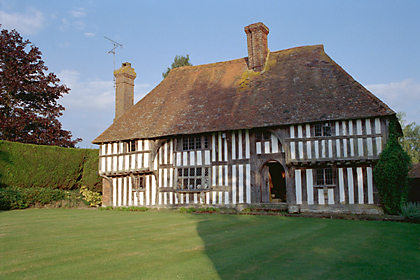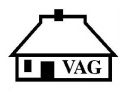Wealden Houses Database
Vernacular Architecture Group (VAG), 2012. https://doi.org/10.5284/1011977. How to cite using this DOI
Data copyright © Vernacular Architecture Group (VAG) unless otherwise stated
This work is licensed under the ADS Terms of Use and Access.
Primary contact
Catherine
Murray
Vernacular Architecture Group (VAG)
Resource identifiers
- ADS Collection: 1086
- DOI:https://doi.org/10.5284/1011977
- How to cite using this DOI
Introduction

The Wealden House is a distinctive medieval structural type, found most commonly in Kent and Sussex, for which the name 'recessed-hall house' is also used. It is characterised by having an open hall flanked by floored, jettied end-bays, all under a single roof. Because the wall plate is aligned with the front walls of the end bays, it 'flies' over the hall, where it is usually braced from the corner posts of the end bays, giving the distinctive 'recessed' hall appearance. The term 'Wealden' apparently came into use among members of the Vernacular Architecture Group in the 1950s, reflecting the concentration of examples in the Kentish Weald. As well as the classic form (illustrated), with a hipped roof and two-bay hall, varieties of Wealden houses exist; these include houses with one-bay halls, and with gabled rather than hipped roofs. Most important are the half-Wealdens, which have only one end bay. Urban Wealdens frequently have this form, often adjoining other half-Wealdens, sometimes in terraces (as in Coventry and Battle). However, rural half-Wealdens are surprisingly common. In some cases a Wealden hall and single end have been added to an earlier wing. Other examples apparently form part of staged developments, where it was intended that a second end would be added later to a single-ended Wealden as, for example, at Bayleaf, the well-known Kentish Wealden house re-erected at the Weald and Downland open-air museum.
The initial incentive to map Wealden houses came from an interest in them as showing the diffusion of carpentry techniques. It was also realised that the last full map was published in 1963, almost 50 years ago. Since then, hundreds of new examples have been identified. See Vernacular Architecture, 41 (2010), 37-44 for the current distribution map.
The database has been compiled from previously published lists, from a substantial list compiled by S. E. Rigold and J. T. Smith, from listed buildings including 'Wealden' in their descriptions and from personal communication by many Vernacular Architecture Group members. This version of the database (August 2011) includes 817 entries. Of these, 789 are confirmed or probable examples, while 28 have been rejected as Wealdens, although included in earlier sources. New discoveries or additional information will be appreciated and should be sent using the 'send e-mail enquiry' button.
Vernacular Architecture Group
The Vernacular Architecture Group was formed in 1952 to further the study of lesser traditional buildings. The Group has over 600 members, including some 50 overseas members, and a number of affiliated groups and exchanging societies. Membership is open to anyone interested in vernacular architecture. Members are involved in all aspects of the recording and study of vernacular buildings including detailed local or regional surveys, studies of particular types of buildings, building materials and techniques, documentary evidence and principles of development.
Other VAG collections include:





